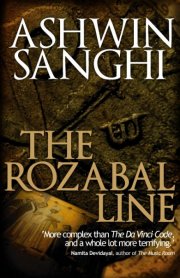
Lashkar-e-Taiba is a Pakistan-based terrorist group, militant and Islamist Salafi jihadist organisation. Described as one of Pakistan's "most powerful jihadi groups", it is most infamous outside Pakistan. The organisation's primary stated objective is to merge the whole of Kashmir with Pakistan. It was founded in 1985–86 by Hafiz Saeed, Zafar Iqbal Shehbaz Abdullah Azzam and several other Islamist mujahideen with funding from Osama bin Laden during the Soviet–Afghan War. It has been designated a terrorist group by numerous countries.
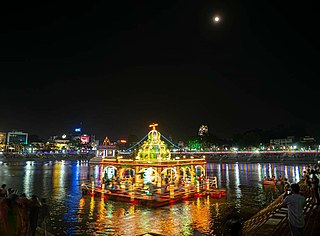
Mylapore, or Thirumayilai, is a neighbourhood in the central part of the city of Chennai, India. It is one of the oldest residential parts of the city. The locality is claimed to be the birthplace of the celebrated Tamil philosopher Valluvar, and the Hindu saint and philosopher, Peyalvar.
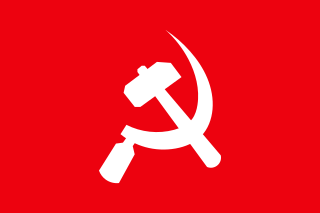
The Communist Party of India (Maoist) is a banned Marxist–Leninist–Maoist communist political party and militant organization in India which aims to overthrow the "semi-colonial and semi-feudal Indian state" through protracted people's war. It was founded on 21 September 2004, through the merger of the Communist Party of India (Marxist–Leninist) People's War (People's War Group) and the Maoist Communist Centre of India (MCCI). The party has been designated as a terrorist organisation in India under the Unlawful Activities (Prevention) Act since 2009.
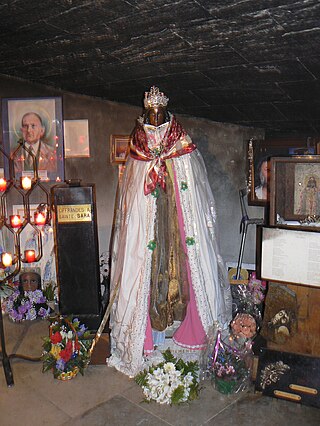
Saint Sarah, also known as Sara-la-Kâli, is the patron saint of the Romani people. The center of her veneration is Saintes-Maries-de-la-Mer, a place of pilgrimage for Roma in the Camargue, in Southern France. Legend identifies her as the servant of one of the Three Marys, with whom she is supposed to have arrived in the Camargue. Saint Sarah also shares her name with the Hindu goddess Kali who is a popular goddess in northern India from where the Romani people originate. The name "Sara" itself is seen in the appellation of Durga as Kali in the famed text Durgasaptashati.

The Roza Bal, Rouza Bal, or Rozabal is a shrine located in the Khanyar quarter in downtown area of Srinagar in Kashmir, India. The word roza means tomb, the word bal mean place. Locals believe a sage is buried here, Yuz Asaf, alongside another Muslim holy man, Mir Sayyid Naseeruddin.

The Da Vinci Code is a 2003 mystery thriller novel by Dan Brown. It is Brown's second novel to include the character Robert Langdon: the first was his 2000 novel Angels & Demons. The Da Vinci Code follows symbologist Robert Langdon and cryptologist Sophie Neveu after a murder in the Louvre Museum in Paris causes them to become involved in a battle between the Priory of Sion and Opus Dei over the possibility of Jesus Christ and Mary Magdalene having had a child together.
The Chittisinghpura massacre refers to the mass murder of 35 Sikh villagers on 20 March 2000 in the Chittisinghpora (Chittisinghpura) village of Anantnag district, Jammu and Kashmir, India on the eve of the American president Bill Clinton's state visit to India.

The theory of Kashmiri descent from the lost tribes of Israel posits that the Kashmiri people originally descended from the Ten Lost Tribes.

The 2008 Mumbai attacks were a series of terrorist attacks that took place in November 2008, when 10 members of Lashkar-e-Taiba, a militant Islamist organisation from Pakistan, carried out 12 coordinated shooting and bombing attacks lasting four days across Mumbai. The attacks, which drew widespread global condemnation, began on Wednesday 26 November and lasted until Saturday 29 November 2008. A total of 175 people died, including nine of the attackers, with more than 300 injured.
Attribution of the 2008 Mumbai attacks were first made by the Indian authorities who said that the Mumbai attacks were directed by Lashkar-e-Taiba militants inside Pakistan. American intelligence agencies also agree with this attribution. Pakistan initially contested this attribution, but agreed this was the case on 7 January 2009. To back up its accusations, the Indian government supplied a dossier to Pakistan's high commission in Delhi. The Pakistan government dismissed the dossier as "not evidence," but also announced that it had detained over a hundred members of Jamaat-ud-Dawa, a charity linked with Lashkar-e-Taiba. In February 2009, Pakistan's Interior Minister Rehman Malik agreed that "some part of the conspiracy" did take place in Pakistan.
Hindu terrorism, sometimes called Hindutva terror or, metonymically, saffron terror, refer to terrorist acts carried out on the basis of motivations in broad association with Hindu nationalism or Hindutva.

Ashwin Sanghi is an Indian writer. His novels include The Rozabal Line, Chanakya's Chant, The Krishna Key, The Sialkot Saga, Keepers Of The Kalachakra, The Vault of Vishnu, and The Magicians of Mazda.
During and immediately after the 2008 Mumbai attacks the news media worldwide broadcast incorrect factual information on a scale often seen in a fog of war. Erroneous reporting on the 2008 Mumbai attacks included false information concerning the number of attackers, their nationality, their organizational affiliations, origins, and the methods of transport they had used. Theories and speculations were openly aired by various commentators that were later proved to be wrong. Many such speculations, such as the involvement in the attacks of the "Deccan Mujahideen", were widely reported by media worldwide. Various news outlets carried opinion pieces and unattributed theories about the origins of the attackers which were unfounded.
Hashmat Ullah Khan, also spelled Hashmatullah Khan, is a Kashmiri Kani shawl promoter and entrepreneur. In 2009, he was conferred the Padma Shri, India's fourth highest civilian honour, for reviving the weaving of Kani shawls.
Holger Kersten is a German writer on myth, legend, religion, and esoteric subjects. He is best known for speculative books about time Jesus spent in India. Kersten's views have received no support from mainstream scholarship.

Chanakya's Chant (2010) is a novel written by Indian author Ashwin Sanghi. It was written two years after his first novel The Rozabal Line (2008) was released in India. Chanakya's Chant was released on 26 January 2011 and entered all major Indian national bestseller lists within two months. It reached #1 on India Today's bestseller list on 4 April 2011. On 19 June 2011, UTV Software Communications announced that it had acquired the movie rights of the novel.
The 2011 Indian Premier League final was a day/night Twenty20 cricket match played between the Chennai Super Kings and the Royal Challengers Bangalore on 28 May 2011 at the M. A. Chidambaram Stadium, Chennai to determine the winner of the 2011 Indian Premier League, an annual professional Twenty20 cricket league in India. It ended as the defending champion Super Kings defeated the Royal Challengers by 58 runs.

In recent Ahmadi Muslim belief, the Mai Mari da Ashtan is the burial place of Mary, mother of Jesus, at one extremity of Muree in Pakistan.

Satyarth Nayak is an Indian author and screenwriter, known for his bestselling novel The Emperor's Riddles, authoring the biography of Sridevi and for scripting Sony's historical television epic Porus. The Emperor's Riddles turned out to be a bestselling thriller with the media calling it "a hit with young readers". Porus created by Swastik Productions was one of the most expensive and acclaimed shows on Indian television. Satyarth's biography of screen legend Sridevi titled Sridevi: The Eternal Screen Goddess published in 2019 by Penguin Random House also went on to win high praise. Satyarth has been named one of the Top 50 Indian authors to follow on social media.
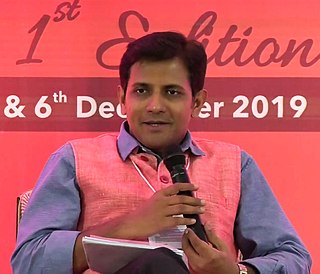
Tuhin Amar Sinha is an Indian author of political thrillers, romance novels and non-fiction works. He has also been active as a newspaper columnist and scriptwriter for television. Since 2016, Sinha has been a spokesperson for the Bharatiya Janata Party (BJP).
